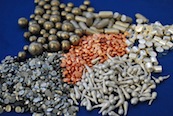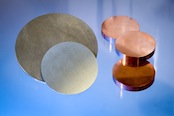Aluminum - Machining
Typical Physical Properties:
Density: 2698 kg ⋅ m-3
Vapor Pressure: 3.7 ⋅ 10-3 Pa (to 927 oC)
Melting Point: 660 oC
Boiling Point: 2056 oC
Mass Internal Energy: 3.98 ⋅ 105 J ⋅ kg-1
Mass Thermal Capacity: 897 J/kg ⋅K (to 25 oC)
Thermal Conductivity: 237 W/m ⋅ K (to 27 oC)
Thermal Expansion: 21 µm/m ⋅ K (-100 to 20 oC)
Modulus of Longitudinal Elasticity: 62 GPa
Coefficient of Linear Expansion: 23.1 10-6 ⋅ K-1 (to 25 oC)
Electrical Resistivity: 26.548 ⋅ 10-3 µΩ ⋅ m (to 25 oC)
Magnetic Susceptibility: 0.6 ⋅ 10-3 (to 25 oC)
Poisson’s Ratio: 0.33
Machining Aluminum and Aluminum Alloys:
Traditional machining operations such as turning, milling, boring, tapping, sawing etc. are easily performed on aluminum and its alloys. The machines that are used can be the same as for use with steel, however optimum machining conditions such as rotational speeds and feed rates can only be achieved on machines designed for machining aluminum alloys.
The specific properties of aluminum alloys must be considered:
‒ their density allows high speeds of rotation and translation as the inertia of aluminum alloy swarf is less than that of steel,
‒ their modulus of elasticity - one third that of steel - requires appropriate chucking and clamping arrangements that avoid deformation and distortion,
‒ their thermal conductivity assists heat dissipation. Given the high rate of chip removal, the heat generated by the machining process is taken away with the swarf without having the time to diffuse into the metal,
‒ a coefficient of linear expansion that is twice that of steel makes heating undesirable if criteria of dimensional stability are to be satisfied.
Unlike steel, there is no need to provide heat treatment of the “stress-free annealing” type during machining.
Cutting Force:
The specific cutting force needed to machine aluminum alloys is far less than is required for steel. For the same section of swarf, the force is one third of that required for aluminum than for low-carbon steel, so it follows for the same cutting force, chip removal is three times higher with aluminum alloys such as 2017A whose level of mechanical properties is on a par with that for low-carbon steel.
Tooling:
The geometry of tools must be specially designed for use with aluminum alloys. Edges must be very keen and cutting tool faces must be highly polished so as to remove swarf efficiently and prevent it from bonding to the tool. Cutting angles will depend on the alloys. The rake angle of the cutting edge must be greater than 6 o and can attain 12 o.
The use of tools tipped with TiN or TiCN by PVD deposition only is highly advisable for machining alloys that contain no more than 7% silicon. (Angle of 15 o for diamond coated carbide (CVD Diamond) tools and polycrystalline diamond (PCD) tools.) Provided tooling is designed for aluminum alloys, tool life is much longer than for machining steels, all other factors being equal.
All wrought alloys can be machined very rapidly. With special machines (high speed spindles) the machining speed can attain (and exceed) 2 to 3000 m/min with 2000 and 7000 series alloys. Thus for a 12 mm diameter tool the cutting rate can be as high as 50,000 r.p.m. for a feed rate of 10 m/min. With very high cutting rates it is possible to obtain very thin sheet and much lighter components.
Rate of Advance and Depth of Cut:
Given the low modulus of aluminum alloys, high rates of advance are not advisable, even for rough machining. The feed rate should be limited to 0.3mm per revolution. For finishing operations the rate of advance will be determined by the specified surface roughness for the finished product. The depth of cut will depend on the specified accuracy.
Lubrication:
Lubrication is a very important factor in the machining of aluminum alloys, and has three main functions:
‒ cooling to dissipate the heat generated by cutting and friction,
‒ preventing swarf from bonding to the tools,
‒ removing swarf from the point of machining.
Although three types of lubrication are available- spray mists, full cutting oil, and oil emulsions- the latter option is the most common because this method dissipates more calories per kilo of lubricant, of the order of 200 kg/J. Cutting fluids reduce friction and aid tapping operations. Lubricant spray mists are not advisable where a lot of heat has to be dissipated.
The composition of cutting fluids must meet other requirements:
‒ they must be compatible with aluminum alloys, they must not cause stains or surface corrosion (no chlorine or sulfur compounds,
‒ they must have an anti-bacterial action to prevent fungal growth,
‒ they must be environmentally friendly.
Lubricant manufacturers can supply products to match all types of machining.

 ALLOYS
ALLOYS 





